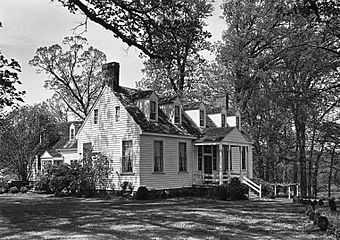Wigwam (Chula, Virginia) facts for kids
|
Wigwam
|
|

The Wigwam – home of Virginia Governor William Branch Giles and the Harrison family
|
|
| Location | 4 mi (6.4 km) northeast of Lodore, Virginia |
|---|---|
| Area | 0 acres (0 ha) |
| NRHP reference No. | 69000220 |
Quick facts for kids Significant dates |
|
| Added to NRHP | November 25, 1969 |
The Wigwam is a historic house built in 1790. It's located near the Appomattox River in Amelia County, Virginia. This beautiful home is built in the Cape Cod style. It was once the home of William Branch Giles, who was a governor of Virginia. He lived there until he passed away in 1830.
Contents
The Wigwam's Story: A Historic Home
The Wigwam has a long and interesting history. It started as a smaller building and grew over time. Many families have lived here and made their mark on the house.
Building the Wigwam: From Small to Grand
The very first part of the Wigwam was built in the 1700s. This was the back section of the house. Later, in 1818, a larger, more formal front section was added. Some people thought this front part might have been moved from another estate. However, experts who studied the house said this wasn't true.
The house is quite large, with 18 rooms inside. It has 4 chimneys that serve 13 fireplaces, keeping the house warm. There are also 65 windows, including 17 dormer windows that stick out from the roof. One room in the basement has a barred window. It is thought this room might have been used to hold prisoners during the American Civil War.
The Harrison Family and Amelia Academy
In 1832, the Wigwam was sold to William Henry Harrison. He was a descendant of the famous Harrison family of Virginia. William Henry Harrison and his wife, Lucy, raised their six children in the Wigwam. They also started a school for boys right in their home. This school was called Amelia Academy.
The main goal of Amelia Academy was to help students get ready for college. Many students went on to attend the University of Virginia in Charlottesville. In 1859, the school had 25 students. A well-known person named John Hartwell Cocke was on the school's board.
A New Generation at the Wigwam
As William Henry Harrison got older, his oldest son, J. Hartwell Harrison, helped him run the school. Eventually, J. Hartwell Harrison closed the school. He and his wife, Anna, made the Wigwam their family home. They also had six children there.
After fighting in the Civil War, Hartwell returned to the Wigwam. He became a farmer and also served as the local Baptist minister.
Challenges and Renovations
Life was not always easy at the Wigwam. In 1896, the family faced tough times due to a period called the Long Depression. They lost the house because they couldn't pay their mortgage. Hartwell's brother-in-law, Lewis Harvie Blair, took ownership.
Later, in the mid-1900s, Hartwell's son, Robert N. Harrison, bought the property. He worked hard to renovate and improve the house.
Recognizing the Wigwam's Importance
The Wigwam's historical value was officially recognized in 1969. It was added to the National Register of Historic Places. This means it's considered an important part of the country's history. In the 1990s, new owners made even more big renovations to the home and farm.
Images for kids




